The native aristocrat
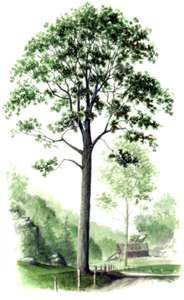
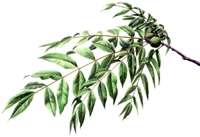
Ancient Romans loved wal nuts, and thought so highly of the meaty fruit that they planted the tree throughout south central Europe and England. Attention always focused on walnut for its nut crop, while oak prevailed as the choice for furniture.
In America, though, native black walnut has always been prime stock. While frontier families gathered walnuts to eat, city craftsmen worked the dark wood into classic pieces. Today, black walnut continues as the aristocrat of native hardwoods and the hallmark of tradition.
Wood identification
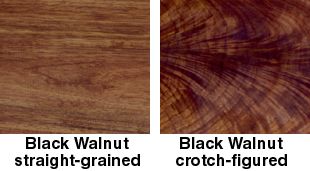
European walnut (Juglans regia) carries the names of countries and regions, such as English walnut, French walnut, and Circassian walnut from the Caucasus Mountains along the Black Sea. A walnut (Juglans neotropica) also grows in South Amenca.
North America claims walnuts: white walnut or butternut (Juglans cinerea), favored by carvers, and black walnut (Juglans nigra). It’s black walnut, though, that woodworkers covet.
Black walnut’s range covers most of the eastern haff of the U.S. and southern Ontario. However, prime walnut requires moist, deep, rich, well-drained soil, such as found in the upper Mississippi River valley.
In idyllic conditions, walnut reaches a height of 150′ and a 6′ diameter. More commonly, however, it matures at about 100′ with a 3′ diameter. The tree’s thick, dark brown to brownish-gray bark has marked ridges.
Walnut’s distinctive leaves measure 1-2′ in length and carry a dozen or more leaflets. In spring, flowing catkins emerge on branch twigs. In mid-summer, nuts appear.
Walnut’s heartwood varies from a purplish-brown with thin, dark veins to gray-brown and even orange-brown. The narrow sapwood tends to be white.
Unfigured walnut has straight, somewhat open grain. Figured walnut—fiddleback, burl, stump, and crotch—feels coarse-textured. A cubic foot of dry walnut weighs about 39 pounds, making it just a little heavier than cherry.
Uses in woodworking
Walnut remains a favorite for fu niture, paneling, musical instruments, turned bowls, relief carvings, and sculpture. Veneer proves popular in marquetry and as furniture accents. Walnut’s shock-resistance, strength, and stability, also make it perfect for shotgun and rifle stocks.
AvailabiIity
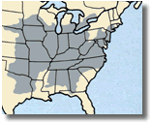
It’s also offered as plywood, furniture squares, buttons, plugs, turning blocks, and dowels.
Machining methods
Black walnut rates as classic cabinet stock not only because of its eye-appeal, but because you get good results with either hand or power tools. It does, however, sometimes require special treatment. Our suggestions:
- Black walnut dust can irritate the eyes, so wear protective goggles, a dust mask, and have adequate ventilation or dust removal.
- Avoid any tearout by taking shallow cuts when jointing. And, try this on the planer: Run two short pieces of stock the same thickness as the walnut board through the planer at the same time—one ahead and one behind. This levels the infeed and outfeed rollers for a chipfree cut.
- In crosscutting, attach a backing board to the miter fence to act as a chip breaker.
- Walnut doesn’t burn easily in routing, but shallow passes eliminate tearout.
- Any adhesive performs well with walnut, but in joining with white or yellow glues, keep glue squeeze-out to a minimum and skim off skinned-over glue. Dry glue discolors the dark wood and shows up in the finish. (Elmer’s new dark glue minimizes this.)
- Straight-grained walnut generally doesn’t require filling. Figured walnut—especially burls and crotch wood—has irregular, more open grain that you should fill.
- Staining walnut isn’t necessary, unless color is uneven. Then, aniline dyes won’t cloud the grain.
- The best finish for walnut is a clear one. Several coats of Danish oil provide clarity. For protection, add a compatible clear topcoat.
Carving comments
Walnut works best for sculptures and large figures with simple lines, or signs and relief carvings. If you do select walnut for a carving project, remember these tips:
- Deep cuts along the grain may cause the wood to pop out.
- Walnut’s grain varies from very open to almost closed, depending on where it grew. Each performs differently. Open-grain walnut carves easier. Closed-grain walnut may be more difficult to carve, but it takes a finer finish.
Turning tips
Walnut turns best at a lathe speed of 800-1,000 rpm, and requires sharp tools. Bowl turners know that walnut’s pronounced end grain in the bottom of a bowl tears easily and produces a rough surface that’s difficult to smooth. Here’s what Arizona turner John Lea does to counter that:
Leave a little extra thickness—about 1/8 » or less-in the end grain at the bowl’s bottom. Then, stop the lathe and with a power disc or flap sander, sand the grain down to a slightly lower level than the surrounding wood. Turn on the lathe and sand the remaining wood around the bottom. This method gives you a round bottom instead of the oval shape you get with the uneven sanding done with the lathe on.
SHOP-TESTED TECHNIQUES THAT ALWAYS WORK
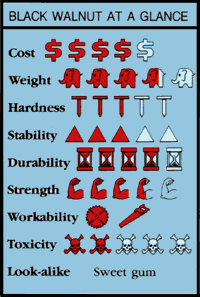
Any exceptions, and special tips pertaining to this issue’s featured wood species, appear under headings elsewhere on this page.
- For stability in use, always work wood with a maximum moisture content of 8 percent.
- Feed straight-grained wood into planer knives at a 90° angle. To avoid tearing, feed wood with figured or twisted grain at a slight angle (about 15°), and take shallow cuts of about 1/32″.
- For clean cuts, rip with a rip-profile blade that has 24-32 teeth. Smooth cross-cutting requires at least a 40-tooth blade.
- Avoid drilling with twist drills. They tend to wander and cause breakout. Use a backing board under the workpiece.
- Drill pilot holes for screws.
- Rout with sharp, preferably carbide-tipped, bits and take shallow passes to avoid burning.
- Carving hardwoods generally means shallow gouge bevels—15° to 20°—and shallow cuts.

